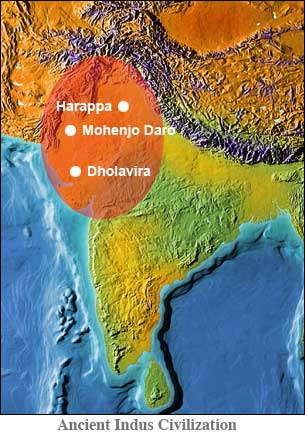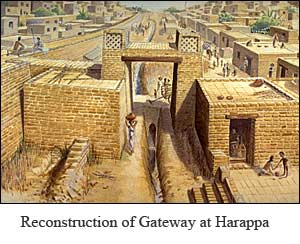The Largest Bronze Age Urban Civilization 
Indus civilization remnants have been discovered from as far south as Mumbai [Bombay], in Maharashtra State, India, and as far north as the Himalayas and northern Afghanistan.
The westernmost sites are on the Arabian sea coast in Baluchistan, Pakistan, right next to the Iranian border.
A thousand miles to the east in India, Harappan settlements have been found beyond India's capital, New Delhi in Uttar Pradesh State. Discoveries in Lothal and Gola Dhoro and Dholavira in Gujarat State suggest a southern coastal network spanning hundreds of miles.
Cultural Development
Indus culture seems to have gradually spread from west to east, with sites towards central and southern India flourishing after Harappa and Mohenjo Daro had declined. The drying up of the ancient Saraswati or Ghaggar-Hakra River, east of and parallel to the Indus, may also have affected the civilization. There are numerous Indus sites along that river bed.
Earlier scholars thought that Indo-Aryan invaders destroyed the Indus cities and pushed the remnant populations into southern India.
 This model is no longer supported, but the decline of the Indus people and the language that they spoke is still a subject of study. It is unclear whether the ancient Harappans would have spoken an Indo-Aryan or Dravidian language, or possibly have spoken even other languages such as Mundari.
This model is no longer supported, but the decline of the Indus people and the language that they spoke is still a subject of study. It is unclear whether the ancient Harappans would have spoken an Indo-Aryan or Dravidian language, or possibly have spoken even other languages such as Mundari.
The existence of the Brahui tribe in Baluchistan, to the west of the Indus, who speak a Dravidian language like Tamil spoken in southeast India, suggests that some migration of people or culture did occur. However, the date for these migrations is not confirmed. The possible endurance of certain Indus signs like the arrow sign is suggestive of some continuity, but this too needs to be studied further.
There also seems to be much greater cultural continuity between ancient Indus times and the era after 1700 B.C.E. until today than earlier archaeologists have tended to recognize. An archaeological look at a contemporary Baluchi fishing village by William Belcher is one such example.
New Research and Writing
 From a look at the mysterious ancient flint mines in the Rohri Hills which date to thousands of years before the greater Indus Civilization (2300 B.C.E.) by Dr. Paolo Biagi [University of Venice] to a tour of new discoveries in Baluchistan by Dr. Ute Franke-Vogt [Aachen University], this site covers some of the exciting discoveries in the larger geographical and cultural stratum that gave birth to the Indus and later Indian civilizations.
From a look at the mysterious ancient flint mines in the Rohri Hills which date to thousands of years before the greater Indus Civilization (2300 B.C.E.) by Dr. Paolo Biagi [University of Venice] to a tour of new discoveries in Baluchistan by Dr. Ute Franke-Vogt [Aachen University], this site covers some of the exciting discoveries in the larger geographical and cultural stratum that gave birth to the Indus and later Indian civilizations.
This site also covers the continuing attempts to decipher the ancient Indus signs and what most scholars regard as one of the world's oldest written languages [for exceptions see Steve Farmer, Richard Sproat [University of Illinois], and Michael Witzel [Harvard University], The Collapse of the Indus-Script Thesis: The Myth of a Literate Harappan Civilization] .
This includes publishing in 2006 the essay Study of the Indus Script recent paper by Dr. Asko Parpola [University of Helsinki], the dean of Indus script research. In 2006 we published his response to Farmer, et. al. In May 2006 we published India's script expert, Iravatham Mahadevan's report on the possible find of a stone axe in Tamil Nadu, south India, with ancient Indus signs on it. There is much more work by both these scholars, as well as Pakistan's Ahmad Hasan Dani, who disagrees with the Indus and Dravidian language link. Geoffrey Cooke has an essay which looks at a single unicorn seal find in Mohenjo Daro.
This site also reported the first early Indus script find dating to 3300 BCE in Harappa in 1999, which puts the origin of Indus signs as early as those of ancient Egypt and Mesopotamia.
Much new research is being undertaken on the ground in India and Pakistan, as well as in Oman and Afghanistan. Radiocarbon chronologies are proving very useful. Satellite imaging is exposing old trade routes. Answers to questions about "Aryan invaders" and the drying up of river beds are likely to be answered in the coming years.
